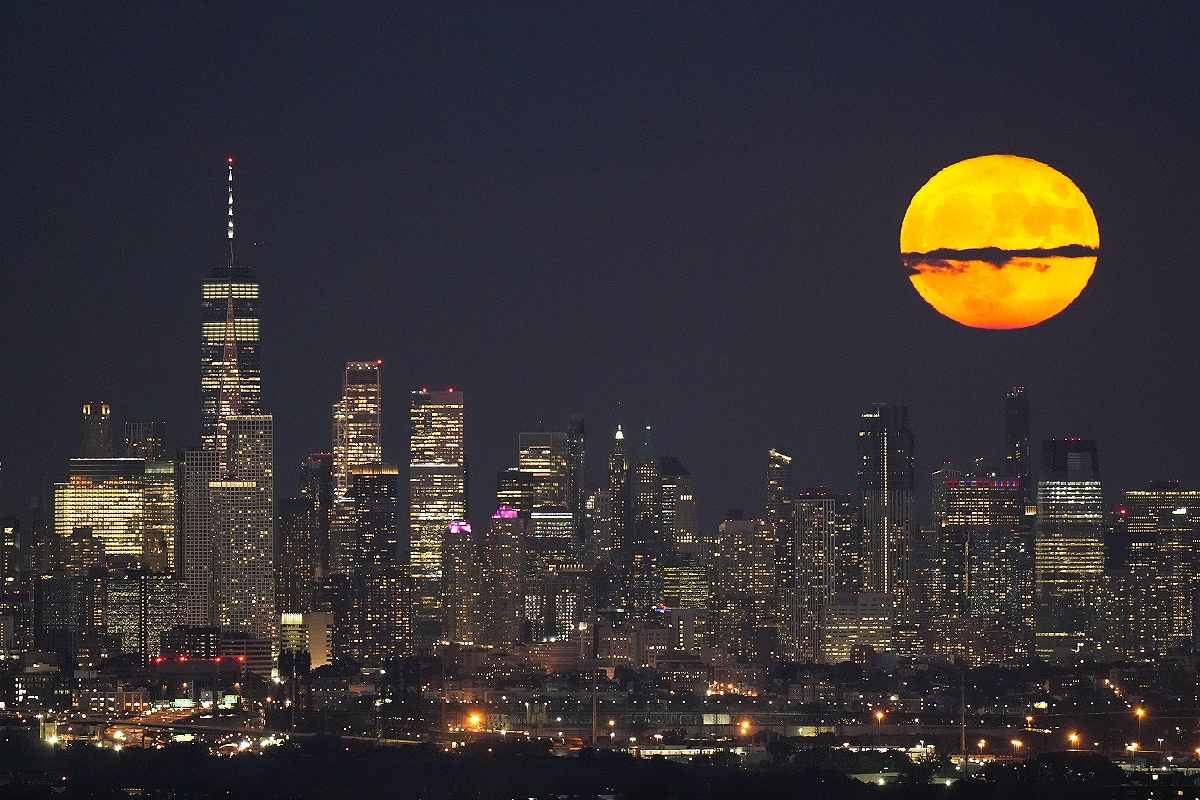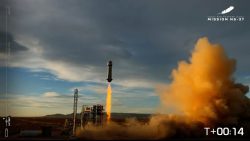
The moon rises through clouds over the skyline of lower Manhattan in this view from West Orange, N.J., Tuesday, Aug. 1, 2023, during a supermoon period.
12:10 JST, August 16, 2024
CAPE CANAVERAL, Fla. (AP) — The first of four supermoons this year rises next week, providing tantalizing views of Earth’s constant companion.
Stargazers can catch the first act Monday as the full moon inches a little closer than usual, making it appear slightly bigger and brighter in the night sky.
“I like to think of the supermoon as a good excuse to start looking at the moon more regularly,” said Noah Petro, project scientist for NASA’s Lunar Reconnaissance Orbiter.
August’s supermoon kicks off a string of lunar spectacles. September’s supermoon will coincide with a partial lunar eclipse. October’s will be the year’s closest approach, and November’s will round out the year.
What makes a moon so super?
More a popular term than a scientific one, a supermoon occurs when a full lunar phase syncs up with an especially close swing around Earth. This usually happens only three or four times a year and consecutively, given the moon’s constantly shifting, oval-shaped orbit.
A supermoon obviously isn’t bigger, but it can appear that way, although scientists say the difference can be barely perceptible.
“Unless you have looked at a lot of full moons or compare them in images, it is hard to notice the difference, but people should try,” Petro said in an email.
How do supermoons compare?
There’s a quartet of supermoons this year.
The first will be 224,917 miles (361,970 kilometers) away. The next will be nearly 3,000 miles (4,484 kilometers) closer the night of Sept. 17 into the following morning. A partial lunar eclipse will also unfold that night, visible in much of the Americas, Africa and Europe as the Earth’s shadow falls on the moon, resembling a small bite.
October’s supermoon will be the year’s closest at 222,055 miles (357,364 kilometers) from Earth, followed by November’s supermoon at a distance of 224,853 miles (361,867 kilometers).
What’s in it for me?
Scientists point out that only the keenest observers can discern the subtle differences. It’s easier to detect the change in brightness — a supermoon can be 30% brighter than average.
With the U.S. and other countries ramping up lunar exploration with landers and eventually astronauts, the moon beckons brighter than ever. As project scientist for the first team of moonwalkers coming up under Apollo’s follow-on program, Artemis, Petro is thrilled by the renewed lunar interest.
“It certainly makes it more fun to stare at,” Petro said.
"News Services" POPULAR ARTICLE
-

American Playwright Jeremy O. Harris Arrested in Japan on Alleged Drug Smuggling
-

Japan’s Nikkei Stock Average as JGB Yields, Yen Rise on Rate-Hike Bets
-

Japan’s Nikkei Stock Average Licks Wounds after Selloff Sparked by BOJ Hike Bets (UPDATE 1)
-

Japan’s Nikkei Stock Average Buoyed by Stable Yen; SoftBank’s Slide Caps Gains (UPDATE 1)
-

Japanese Bond Yields Zoom, Stocks Slide as Rate Hike Looms
JN ACCESS RANKING
-

Keidanren Chairman Yoshinobu Tsutsui Visits Kashiwazaki-Kariwa Nuclear Power Plant; Inspects New Emergency Safety System
-

Imports of Rare Earths from China Facing Delays, May Be Caused by Deterioration of Japan-China Relations
-

University of Tokyo Professor Discusses Japanese Economic Security in Interview Ahead of Forum
-

Japan Pulls out of Vietnam Nuclear Project, Complicating Hanoi’s Power Plans
-

Govt Aims to Expand NISA Program Lineup, Abolish Age Restriction























